Performance monitoring systems are essential for enhancing athlete performance and optimising training regimens. This article explores different types of systems, including wearable technology and data analytics platforms, highlights their benefits such as real-time tracking and injury prevention, and discusses implementation challenges faced by sports organisations. Additionally, emerging trends for 2025 will be examined, focusing on advancements in data analytics and personalised training programmes.
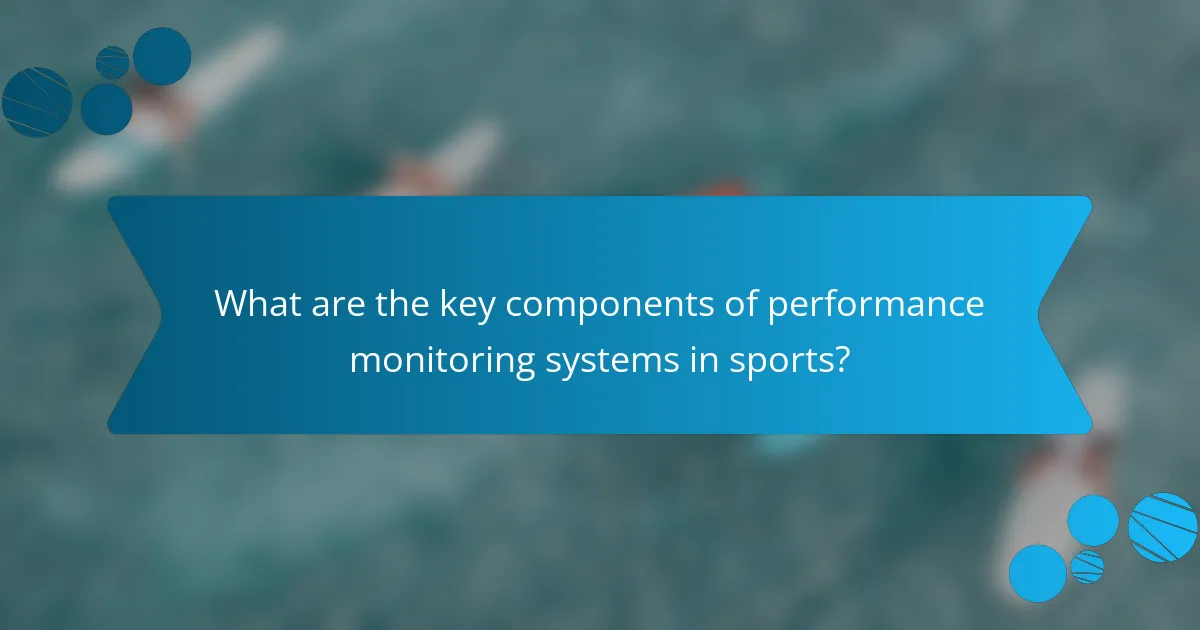
What are the key components of performance monitoring systems in sports?
Performance monitoring systems in sports include data collection, analysis tools, and feedback mechanisms. Key components are wearable technology, performance analytics software, and coaching platforms. These elements enable real-time tracking of athletes’ metrics, enhance training efficiency, and support injury prevention strategies. By integrating these systems, teams can optimise player performance and tailor training regimens based on individual needs.
How do data collection methods influence performance analysis?
Data collection methods significantly impact performance analysis by determining the quality and accuracy of insights gathered. Effective data collection enhances decision-making, enabling coaches and athletes to identify strengths and weaknesses. For instance, real-time tracking technologies provide precise metrics, while surveys capture subjective experiences. Additionally, diverse methods yield comprehensive views of athlete performance, facilitating tailored training programmes. Ultimately, the choice of data collection method shapes the effectiveness of performance monitoring systems in sports.
Which technologies are commonly used in performance monitoring?
Performance monitoring systems commonly utilise technologies such as wearable devices, video analysis software, GPS tracking, heart rate monitors, and performance analytics platforms. These technologies provide real-time data, enabling athletes and coaches to optimise training and performance.
What metrics are most relevant for athlete performance assessment?
Key metrics for athlete performance assessment include strength, speed, endurance, agility, and recovery time. These metrics help coaches tailor training programmes and monitor progress effectively.
| Metric | Description | Importance |
|—————|—————————————–|———————————-|
| Strength | Maximum force exerted | Enhances overall performance |
| Speed | Time taken to cover a distance | Critical for competitive edge |
| Endurance | Ability to sustain prolonged effort | Vital for long-duration events |
| Agility | Quickness in movement and change of direction | Essential for sports requiring quick responses |
| Recovery Time | Duration needed to return to peak performance | Indicates training effectiveness |
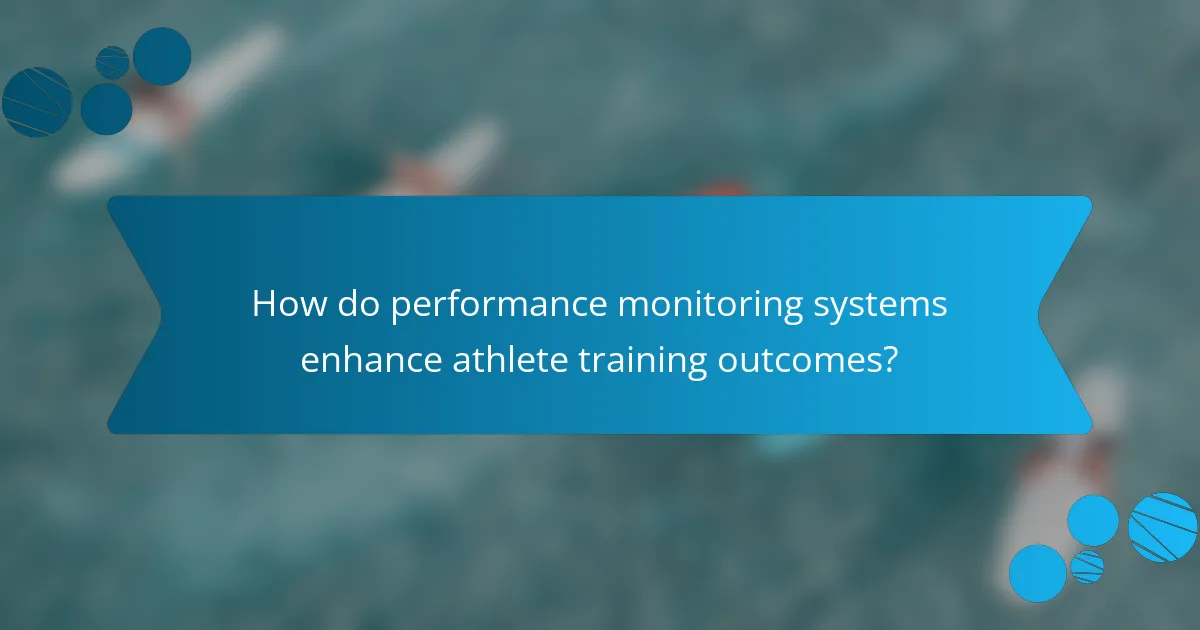
How do performance monitoring systems enhance athlete training outcomes?
Performance monitoring systems significantly enhance athlete training outcomes by providing real-time data on performance metrics. These systems track variables such as heart rate, speed, and recovery times, enabling coaches to tailor training programmes effectively. This data-driven approach allows for personalised feedback, optimising training loads and reducing the risk of injury. As a result, athletes can improve their performance more efficiently and achieve their goals faster.
What are the benefits of real-time feedback for athletes?
Real-time feedback enhances athletes’ performance by providing immediate insights into their training and competition. It allows for timely adjustments, improving skill acquisition and decision-making. Enhanced motivation arises from instant recognition of progress, fostering a growth mindset. Additionally, real-time data helps coaches tailor strategies to individual athlete needs, optimising overall team performance. This feedback loop can lead to better outcomes and reduced injury risk through informed training choices.
How does performance monitoring contribute to injury prevention?
Performance monitoring significantly reduces injury risks by tracking athletes’ physical conditions and workloads. It identifies early signs of fatigue or stress, allowing for timely interventions. By analysing performance data, coaches can tailor training programmes to individual needs, optimising recovery and minimising injury potential. Regular assessments foster a proactive approach to athlete health, ensuring sustained performance and longevity in sports.
Which psychological benefits do athletes gain from performance tracking?
Athletes gain enhanced motivation, self-awareness, and mental resilience from performance tracking. These psychological benefits stem from real-time feedback, allowing athletes to set achievable goals and monitor progress. Improved self-efficacy results from recognising personal growth, while tracking data can reduce anxiety by providing structure. Additionally, performance monitoring fosters a sense of accountability, promoting discipline and focus during training.
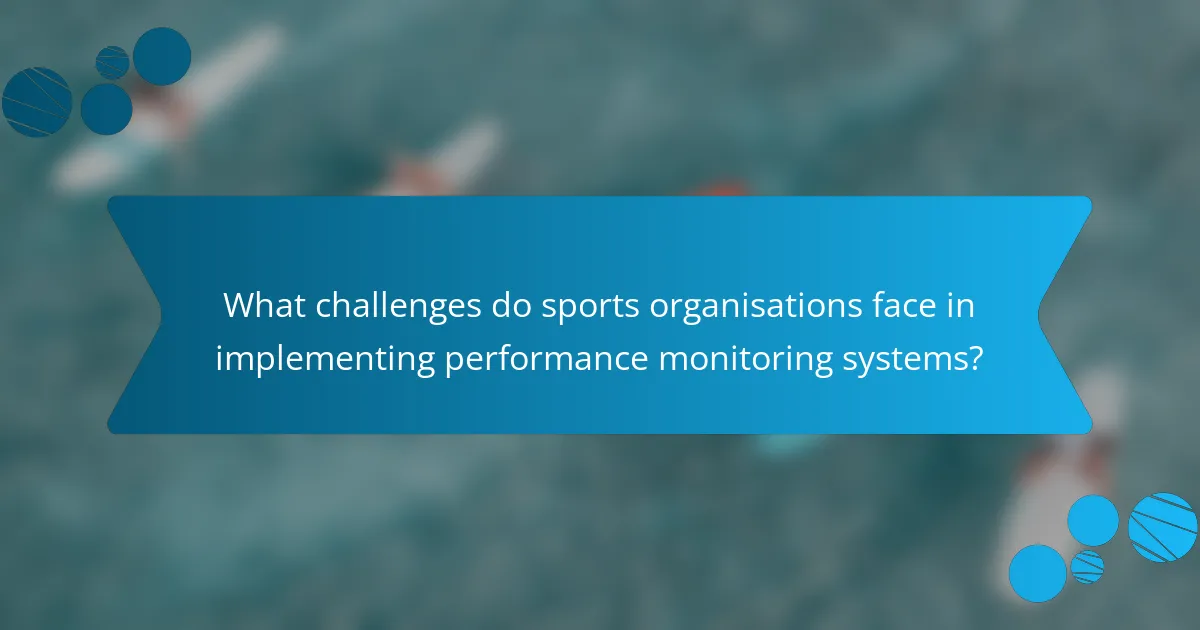
What challenges do sports organisations face in implementing performance monitoring systems?
Sports organisations face several challenges in implementing performance monitoring systems. Key issues include high costs, data integration difficulties, and resistance to change among staff.
High costs can limit access to advanced technology and software necessary for effective monitoring. Data integration challenges arise when consolidating information from various sources, leading to inconsistencies. Additionally, staff resistance can hinder the adoption of new systems, affecting overall performance enhancement efforts.
To address these challenges, organisations should prioritise training, invest in user-friendly technology, and foster a culture of innovation.
How do budget constraints affect the adoption of monitoring technologies?
Budget constraints significantly hinder the adoption of performance monitoring systems in sports. Limited financial resources restrict access to advanced technologies and necessary training for effective implementation.
Cost-effective solutions are often prioritised, leading to a reliance on basic systems that may not deliver optimal performance insights. Additionally, ongoing expenses for maintenance and updates can deter organisations from investing in more sophisticated monitoring technologies.
Moreover, budget limitations can impact the scalability of these systems, preventing teams from expanding their monitoring capabilities as they grow. As a result, sports organisations may miss out on valuable data that could enhance athlete performance and overall team success.
What are the common technical issues encountered during implementation?
Common technical issues during implementation of performance monitoring systems include data integration challenges, system compatibility problems, and user training deficiencies. These issues can lead to inaccurate data collection and hinder performance analysis. Addressing these challenges early can enhance the effectiveness of the system and ensure reliable performance metrics.
How can data privacy concerns impact athlete participation?
Data privacy concerns can significantly impact athlete participation in performance monitoring systems. Athletes may hesitate to share personal data due to fears of misuse or breaches, affecting their willingness to engage in these systems.
Moreover, stringent data protection regulations can limit the types of data collected, hindering comprehensive performance analysis. As a result, teams may struggle to optimise training and recovery without sufficient data.
Trust in data handling practices is crucial for athlete cooperation. Transparent data policies and robust security measures can alleviate concerns and encourage participation.
Ultimately, addressing data privacy is essential for maximising the benefits of performance monitoring systems in sports.
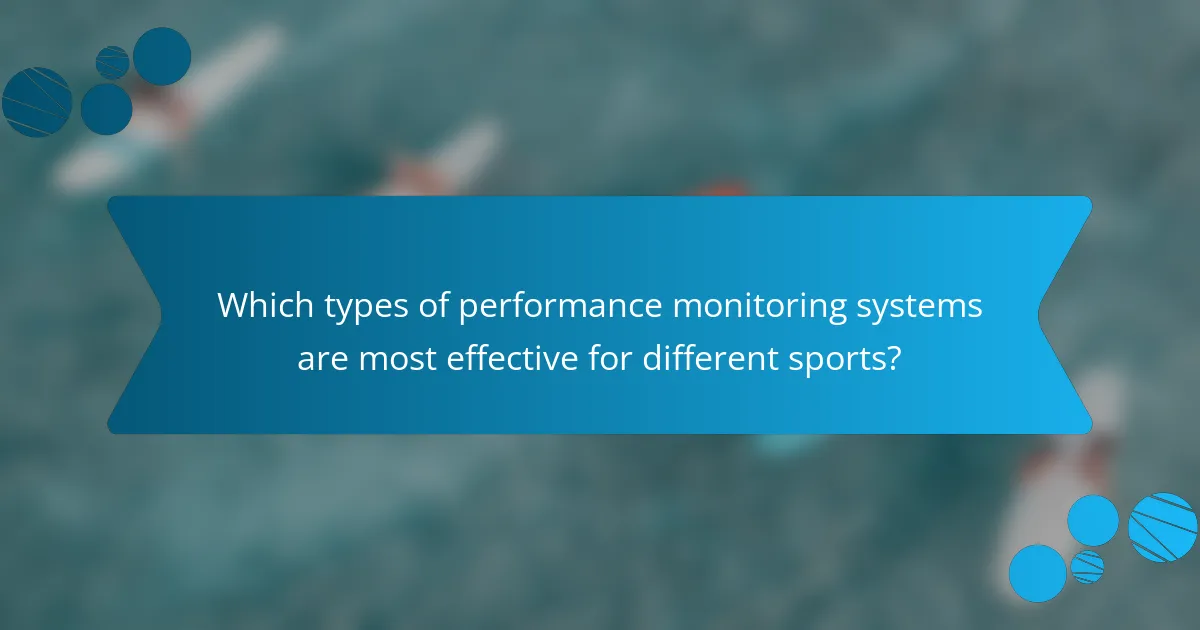
Which types of performance monitoring systems are most effective for different sports?
Wearable technology, video analysis, and data analytics platforms are the most effective performance monitoring systems for different sports. Each type serves unique purposes tailored to specific athletic needs.
Wearable technology provides real-time data on physiological metrics like heart rate and movement patterns, crucial for sports like running and cycling. Video analysis systems enhance technique assessment in sports such as gymnastics and swimming by providing detailed visual feedback. Data analytics platforms aggregate performance metrics, enabling coaches to make informed decisions across team sports like football and basketball.
The selection of a performance monitoring system should consider the unique attributes of the sport, such as the type of data needed and the athletes’ specific performance goals.
What distinguishes team sports from individual sports in monitoring needs?
Team sports require a more collaborative approach to performance monitoring than individual sports. In team sports, monitoring focuses on collective dynamics, communication, and strategy, while individual sports emphasise personal metrics and self-improvement. Team sports benefit from systems that track player interactions, formations, and overall team performance, facilitating real-time adjustments during games. Individual sports often prioritise personal statistics, such as speed or endurance, tailored to the athlete’s unique training needs. This distinction highlights the varying monitoring needs and systems designed to optimise performance in different sports contexts.
How do performance monitoring systems vary across different athletic levels?
Performance monitoring systems vary significantly across athletic levels, adapting to the specific needs and goals of each group. At the elite level, systems focus on comprehensive data analytics, including biomechanics and physiological metrics, to optimise performance. In contrast, amateur athletes may use simpler tools that track basic metrics like heart rate and distance. Youth sports often prioritise user-friendly applications that engage young athletes while providing essential feedback. Each system’s implementation considers the athletes’ experience, the complexity of data required, and the resources available for analysis.
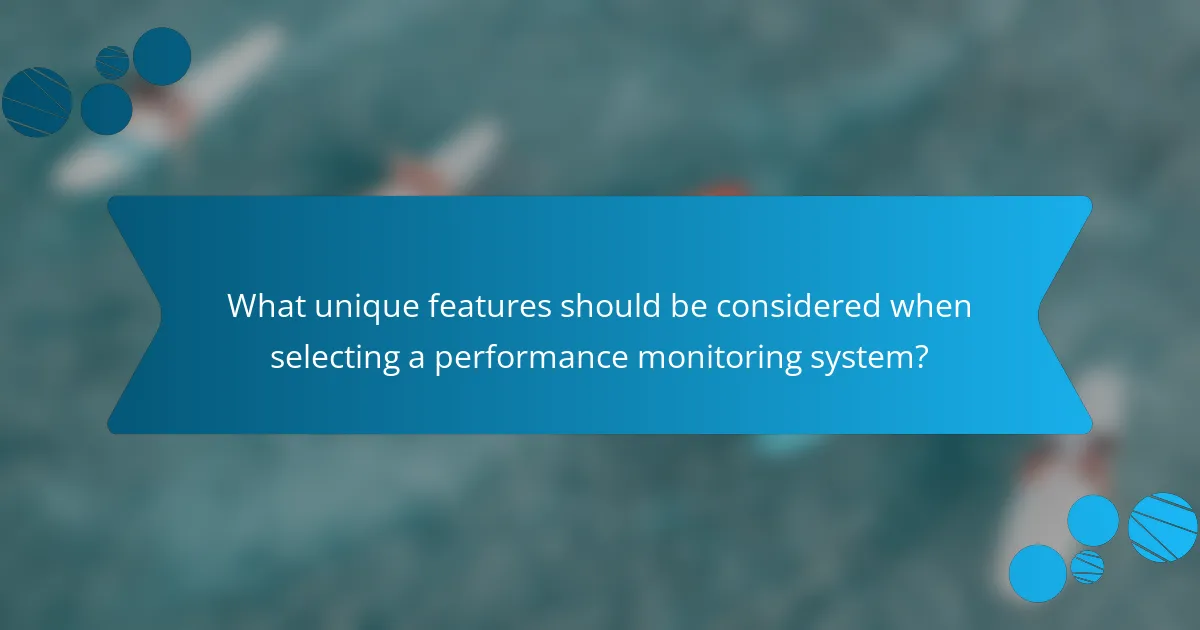
What unique features should be considered when selecting a performance monitoring system?
When selecting a performance monitoring system, consider unique features such as real-time data analysis, customisable metrics, integration capabilities, and user-friendly interfaces. These attributes enhance the system’s effectiveness in tracking athlete performance and improving training outcomes. Additionally, scalability is crucial for accommodating various sports and team sizes.
How does compatibility with existing training programmes influence system choice?
Compatibility with existing training programmes significantly influences system choice by ensuring seamless integration and maximising effectiveness. Systems that align with current methodologies enhance data utilisation and athlete performance tracking. Compatibility reduces the learning curve for coaches and athletes, fostering quicker adoption and consistent usage. This alignment supports the continuity of training regimens, allowing for better performance monitoring and analysis. Ultimately, selecting a performance monitoring system that complements existing programmes leads to improved outcomes and streamlined operations.
What role does user-friendliness play in the effectiveness of monitoring systems?
User-friendliness significantly enhances the effectiveness of performance monitoring systems in sports. Intuitive interfaces allow athletes and coaches to easily interpret data, leading to informed decisions. When systems are user-friendly, they promote consistent usage and engagement, which is crucial for tracking progress and optimising performance. Additionally, clear visualisations of metrics can simplify complex data, making it accessible for all users regardless of technical expertise. This ultimately fosters a culture of continuous improvement and adaptability within sports teams.

What are the emerging trends in performance monitoring systems for 2025?
Emerging trends in performance monitoring systems for 2025 include advanced data analytics, real-time feedback mechanisms, and integration with wearable technology. These systems will leverage artificial intelligence to enhance athlete performance tracking and injury prevention. Increased focus on personalised training programmes will also drive innovation in this space. Enhanced interoperability among devices will ensure seamless data exchange, improving overall efficiency in sports performance monitoring.
How is artificial intelligence shaping the future of performance analysis?
Artificial intelligence is revolutionising performance analysis by providing real-time data insights and predictive analytics. It enhances athlete monitoring through advanced metrics, enabling coaches to make informed decisions. AI-driven systems analyse vast amounts of performance data, identifying patterns that human analysis might overlook. This leads to optimised training regimens tailored to individual athlete needs, improving overall team performance. Additionally, AI tools facilitate injury prediction and prevention, ensuring athletes maintain peak condition throughout their careers.
What innovations are being introduced to enhance data accuracy and usability?
Innovations enhancing data accuracy and usability in performance monitoring systems include advanced algorithms, real-time analytics, and machine learning integration. These technologies improve data collection, interpretation, and application in sports. For example, wearable devices now provide precise biometric data, while cloud-based platforms facilitate seamless data sharing and collaboration among teams. As a result, coaches can make informed decisions based on accurate, actionable insights.
Which upcoming technologies are likely to disrupt traditional monitoring methods?
Emerging technologies such as artificial intelligence, wearables, and IoT are set to disrupt traditional performance monitoring systems in sports. These innovations enhance data accuracy, real-time analysis, and athlete feedback. AI algorithms can predict performance trends, while wearables provide continuous biometric data. IoT devices facilitate seamless data integration across platforms, transforming how coaches and athletes interact with performance metrics.
What best practices should organisations follow when implementing performance monitoring systems?
Organisations should prioritise clear objectives, user training, and regular feedback when implementing performance monitoring systems. Establish measurable KPIs to assess effectiveness and ensure alignment with team goals. Incorporate user-friendly technology to facilitate data collection and analysis. Regularly review and adjust the system based on performance data to enhance accuracy and relevance.